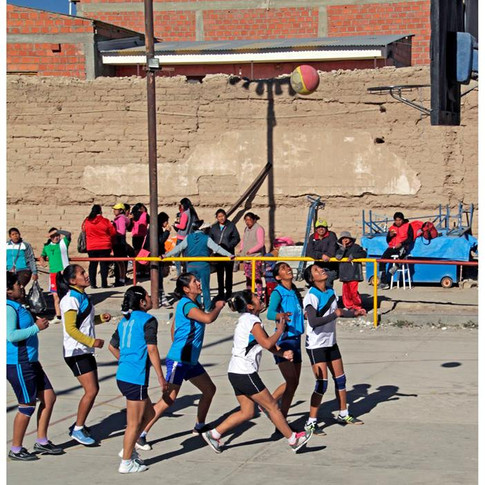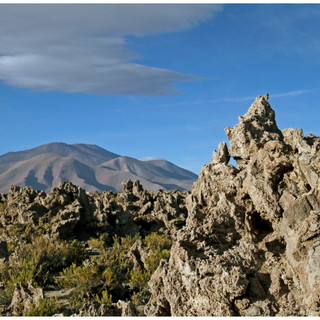
Salt. A LOT of it. Covering more than 10,000 square kilometers, Uyuni is the world’s largest salt pan and arguably one of the most breathtaking locations in South America, if not the world. It is what remains of Lake Minchin, a salt lake that evaporated eons ago and now offers a scenery like from another world. The salt layer is a couple of meters thick and under all that salt lies a rich layer of lithium - almost half of the world's supply. As this resource is in high demand by the automotive industry, which needs it for high-performance batteries for electric cars, a larger scale exploitation will soon start in Uyuni.
But let's forget about the economic side of things: the region is really, really beautiful. Uyuni is basically a mandatory part of every trip to Bolivia and more varied than we had first expected. Apart from the famous salt flats, you can visit big lakes with flocks of flamingos, rocky deserts to climb around, volcanoes, and see some of the most spectacular sunsets you'll ever see.
Getting there Coming from La Paz, you can either fly with Amazonas Air or take the bus, which winds 570km through the mountains on mostly unsealed roads. The bus takes a solid 10-11 hours in good conditions, while the flight is a quick jump of barely one hour. If you opt to ride the bus at night, be aware that the it can quite cold and heating is not always ensured in buses. Oh, and the seats oftentimes don't recline. All things considered, going by plane is probably the easiest option.
As we had read that the local airlines can be a bit unreliable, we were a little hesitant at first, but we have only good things to say about Amaszonas - and air travel in the region in general. Including my arrival and departure, I had seven flights in 14 days, and none was delayed and we had no trouble whatsoever. Coming from Europe, one is transferred back to a time when the security choreography was not as silly and time-consuming as it is today. For the local flights in Bolivia, it was perfectly sufficient to arrive half an hour before take-off. While the backpack was being pulled through that little x-ray car wash, the security guy was always either dozing away, in deep conversation, or stacking boxes in some other room. The planes were little more than buses with wings, but all our flights were quick and without any turbulence. The flight to Uyuni gave us an impression of the vastness of the place. Whichever direction you looked from the plane, it was simply bright and flat.

Uyuni lies on 3,500m altitude, which we only learned on the flight - well-prepared travelers that we are. The city of Uyuni is just a short ride from the airport and while we were still tired from waking up so early for our flight, there is nothing like a 1994 dance classic on the radio to get some energy back:
It was founded as a trading post in 1890, and little seems to have changed. Lots of street markets, a few roads, the long row of tour operators and some cafés - the town of Uyuni is not spectacular, but a pleasant enough stepping stone to start the salt flat adventure. There are numerous tour operators and various options to choose from to explore the region. The length of the tours varies between 1-3-5 days, but I would definitely recommend to spend a bit more time than a day, since the area is huge and offers a great variety of awesome landscapes and experiences, which simply takes some time to cover. We went for the three day tour, which included the 4x4 jeep, accommodation for two nights, food, the airport shuttle and the multi-talented guy who was our driver, guide, and cook for the tour. Since we had some time before the tour started, we explored Uyuni city a bit.
Train Cemetery
Uyuni used to be an important hub through which all trains carrying minerals from the Andes to the Pacific Ocean ports went. After the mining industry collapsed in the 1940's, many trains were abandoned and now form this train cemetery. The tour started off with a visit to the train cemetery, which is just a few minutes outside of the town.
It is easy to overuse the word "surreal" when you travel through Uyuni, but this row of rusty trains is, well, surreal. It's also a photographer's dream to climb around on those photogenic wagons. The only downside of the location is that pretty much all tours make a stop there - and they all start around the same time. So when you arrive, be prepared to see many other jeeps spilling out ecstatic camera-wielding people. Still a pretty cool spot, though. All in all I would recommend to visit the place alone by cab sometime in the morning or evening instead of with the tour groups.
Uyuni Salt Flats

We had seen photos, we had heard stories, but I doubt anything can really prepare for that drive into the vast emptiness of the Uyuni salt flats. The horizon offers no point of reference to estimate distances or orientate oneself. It quickly becomes clear that having a reliable car and a driver who knows the area by heart is not only about convenience; it is a real necessity in such a surrounding.
After about an hour of driving in which we lost all sense of direction, a little spot appeared in the distance and became larger by the minute - a café made out of salt, in the middle of the void. We stopped there and had a stroll around the row of flags, which had been set up in front of the building. The sight and sound of those flags flapping around in the strong desert wind was a hypnotic and colorful display of the nations.
Once inside the café, our driver/guide/cook put a couple of pots on the table. The usual Bolivian mix of chicken, rice, and some vegetables - simple, but tasty. The table, our chairs, everything was made of salt. I quite liked the idea that you could just rub your food on the table should it happen to be a bit stale.


The crew inside the salt café
Back in the jeep our driver steered into the endless white and led us to a spot with unobstructed views to the horizon in all directions. We were visiting in June, others highlight that you should visit Uyuni during the rainy season between January and April. In those months water covers the area and turns the world's largest salt flat into the world's largest mirror. The line between sky and land disappears and the result is simply stunning. Just look at this video to get an idea. We thoroughly enjoyed the dry season, though - the weather was on our side during the whole time in Bolivia, and we goofed around in the salt, fiddling with perspective and camera angles to take our mandatory Uyuni photos. Touristy? Yeah. Tacky? Absolutely. And also all kinds of fun!
Isla de los Pescados - Hiking Cactus Island

In an area that is not short of otherworldly landscapes, the sudden appearance of a landmass that is filled with cacti still manages to stand out. And stand out it does. Apart from the distant mountains (the ones in the background of the photo are a good 100km away!), this spot is the only place from which you can look at the endless salt flats from an elevated point of view.
It costs something around 30 Bolivianos (~4€) to climb the island, but that's money well spent for a nice hike on the well-kept path that leads you on and around the hill. Since we spent hours and hours in the jeep to cover the vast distances between the various spots in Uyuni, the little stroll was a welcomed opportunity to stretch our legs. And to once more point out the dimension of the place: that tiny speck on the right side of the photo is a jeep.
Alpacas, flamingos, volcanoes and sleeping on salt

It is not every day that you can say that you slept in a house made of salt, on a bed made of salt. It might not sound like the most comfortable of setups, but the mattress was decent and after a couple of hours in a jeep, any surface that allows you to stretch your legs is great.
The temperature is a different story - the buildings do not have central heating and temperatures can drop to -15° or even -20° Celsius at night. I put on long woolen socks, fashionable long underwear, climbed first into a sleeping bag inlet, then the sleeping bag, threw a blanket over me, spent a few minutes to make entirely sure that all possible gaps were covered, and nestled down in my cozy shelter. Of course that's when I realized I had to go to the bathroom so I had to go through the whole process again.
The desert is not as dry and dead as one might assume at first: Laguna Cañapa and Laguna Hedionda with its flocks of pink and white flamingos were a highlight, as were the grazing llamas and alpacas (more photos below).
After crossing a railroad track, which dates back to the time when Bolivia still had access to the Pacific Ocean and was used to transport ore to the harbor trading posts, we came to a spot with strangely shaped rocks, of which the most famous is the Arbol de Piedra ("stone tree"). It stands 7m high and gives you an idea of how the desert wind carrying sand and salt slowly erodes everything in its path. We got an idea of its power a few minutes later, when a sand storm blew fine dust and sand in our faces. I bet after a few hours in that wind we might have looked not unlike that stone tree.

The volcanic landscapes we visited in the morning hours of our third day in Uyuni were something that we had not had on our mental agenda when we planned the trip, so were quite excited when we got out of the car after a 45min ride from the hotel. We arrived at the area named “Sol de Mañana” just in time to see the jeep of an earlier tour disappearing in a smoke plume like a mirage. There are mud lakes and steam pools with boiling mud all around you while you take a little walk outside. It is however on almost 5000m altitude and very cold and windy, so after a few minutes we were glad to hop into the jeep again.
When you drive long distances between the individual stops and sights on a tour that lasts for days, there is a risk that said sight might not live up to the anticipation which builds up on the drive. Not the case in Uyuni. We were genuinely stunned time and time again.
Things to add:
Due to the relentless sun reflecting from the surface, Uyuni is a very bright and dry place (duh!). Bring sunglasses, sunscreen and some extra water - food and drinks are provided by the tour, but better to have some extra in the jeep.
Winds are harsh, and at night it can get very cold. Have a warm sleeping bag (or a regular one plus inlet) ready, dress in several layers so you can adjust to the situation, a soft shell and a windproof jacket should be in your bag. Also bring a hat and some lip balm.
Not all tours include the entrance to the national parks, so have some Bolivianos with you. Some of the places also charge you for the bathroom or a warm shower. Toilet paper is also a rare commodity in the desert.
If you happen to have a horribly chatty girl join the group mid-tour at one of the stops, and she won't stop talking in a slightly annoying voice for hours, never failing to mention that she has done even more incredible tours before and has lived in many countries and knows everything about any culture, you might at first be distraught. You might also be secretly cheerful when altitude sickness happens to catch up with said girl and shuts her right up for the remaining days.
Bring extra batteries for your cameras and a powerbar for your phone. The entire area is just ridiculously photogenic and you don't want to run out of juice out there. You can charge your stuff for a few coins in the huts, too.
The light meter of your camera might give you underexposed photos when you point it directly at the bright surface - change the settings to "overexpose" the photos by just the right amount in those cases.
Having your lunch inside of a jeep, sitting in an uncomfortable and slightly awkward position is still better than chewing on a meal made crunchy by the sand and salt blown onto it by the desert wind.
There are a few hot springs you can swim in. Bring your swim wear if you fancy that.
Because the surrounding is so flat, the sun will set in an unfamiliar angle, in dreamlike colors of all shades. Also, your shadow will be ridiculously long (see cover image).
Having a pocket flask with whisky makes every evening better.
You will be in the jeep for hours on end, which means a lot of time for banter and never-ending lame jokes among friends. Make sure to go with people you know well enough to not strangle them at some point during the tour.














































